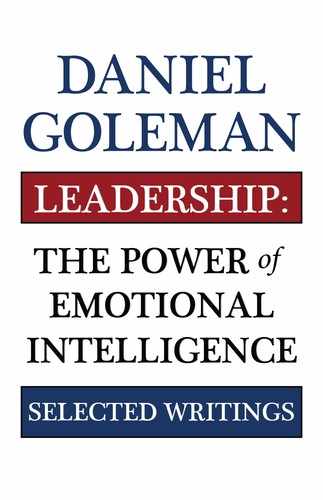THE SWEET SPOT FOR ACHIEVEMENT
Adapted From Social Intelligence
You are driving to work, planning an important meeting with a colleague, and intermittently reminding yourself that you must remember to turn left at the traffic light, not right as usual, so you can drop your suit at the cleaners.
Suddenly an ambulance screams up behind you, and you speed up to get out of the way. You feel your heart quicken.
You try to resume planning the morning’s meeting, but your thoughts are disorganized now and you lose concentration, distracted. When you get to work, you berate yourself because you forgot to go to the cleaners.
This scenario comes not from some business primer but from the academic journal Science, as the beginning of an article called “The Biology of Being Frazzled.”49 The article summarizes the effects on thinking and performance caused by being mildly upset – frazzled from the hassles of daily life.
“Frazzle” is a neural state in which emotional upsurges hamper the workings of the executive center. While we are frazzled, we cannot concentrate or think clearly. That neural truth has direct implications for achieving the optimal emotional atmosphere both in the classroom and the office.
From the vantage point of the brain, doing well in school and at work involves one and the same state, the brain’s sweet spot for performance. The biology of anxiety casts us out of that zone for excellence.
“Banish fear” was a slogan of the late quality-control guru W. Edwards Deming. He saw that fear froze a workplace: workers were reluctant to speak up, to share new ideas, or to coordinate well, let alone to improve the quality of their output. The same slogan applies to the classroom – fear frazzles the mind, disrupting learning.
The basic neurobiology of frazzle reflects the body’s default plan for emergency. When we are under stress, the HPA axis roars into action, preparing the body for crisis. Among other biological maneuvers, the amygdala commandeers the prefrontal cortex, the brain’s executive center. This shift in control to the low road – the brain’s subcortical areas – favors automatic habits, as the amygdala draws on knee-jerk responses to save us. The thinking brain gets sidelined for the duration; the high road, the cortex or thinking center, moves too slowly.
As our brain hands decision-making over to the amygdala circuitry, we lose our ability to think at our best. The more intense the pressure, the more our performance and thinking will suffer.50 The ascendant amygdala handicaps our abilities for learning, for holding information in working memory, for reacting flexibly and creatively, for focusing attention at will, and for planning and organizing effectively. We plunge into what neuroscientists call “cognitive dysfunction.”51
“The worst period I ever went through at work,” a friend confides, “was when the company was restructuring and people were being ‘disappeared’ daily, followed by lying memos that they were leaving ‘for personal reasons.’ No one could focus while that fear was in the air. No real work got done.”
Small wonder. The greater the anxiety we feel, the more impaired is the brain’s cognitive efficiency. In this zone of mental misery, distracting thoughts hijack our attention and squeeze our cognitive resources. Because high anxiety shrinks the space available to our attention, it undermines our very capacity to take in new information, let alone generate fresh ideas. Near-panic is the enemy of learning and creativity.
The neural highway for dysphoria runs from the amygdala to the right side of the prefrontal cortex. As this circuitry activates, our thoughts fixate on what has triggered the distress. And as we become preoccupied by, say, worry or resentment, our mental agility sputters. Likewise, when we are sad, activity levels in the prefrontal cortex drop and we generate fewer thoughts.52 Extremes of anxiety and anger on the one hand, and sadness on the other, push brain activity beyond its zones for effectiveness.
Boredom fogs the brain with its own brand of inefficiency. As minds wander, they lose focus; motivation vanishes. In any meeting that has gone on too long (as so many do), the vacant eyes of those trapped at the table will betray this inner absence. And we all remember days of ennui as students, absently staring out the window.
But joyous moments, says University of Southern California neuroscientist Antonio Damasio, signify “optimal physiological coordination and smooth running of the operations of life.” Damasio, one of the world’s leading neuroscientists, has long been a pioneer in linking findings in brain science to human experience. Damasio argues that more than merely letting us survive the daily grind, joyous states allow us to flourish, to live well, and to feel well-being.
Such upbeat states, he notes, allow a “greater ease in the capacity to act,” a greater harmony in our functioning that enhances our power and freedom in whatever we do. The field of cognitive science, Damasio notes, in studying the neural networks that run mental operations, finds similar conditions and dubs them “maximal harmonious states.”
When the mind runs with such internal harmony, ease, efficiency, rapidity, and power are at a maximum. We experience such moments with a quiet thrill. Imaging studies show that while people are in such exhilarating, up-beat states, the area of the brain that displays most activity is in the prefrontal cortex, the hub of the high road.
Heightened prefrontal activity enhances mental abilities like creative thinking, cognitive flexibility, and the processing of information.53 Even physicians, paragons of rationality, think more clearly when in good moods. Radiologists work with greater speed and accuracy after getting a small mood-boosting gift – and their diagnostic notes include more helpful suggestions for further treatment, as well as more offers to do further consultation.54
